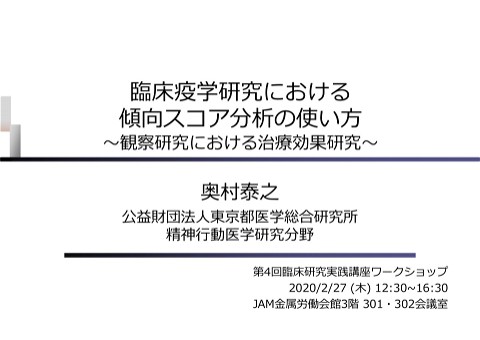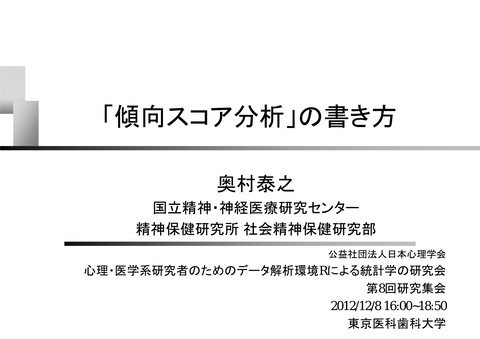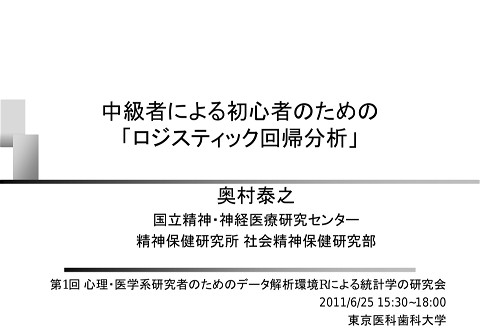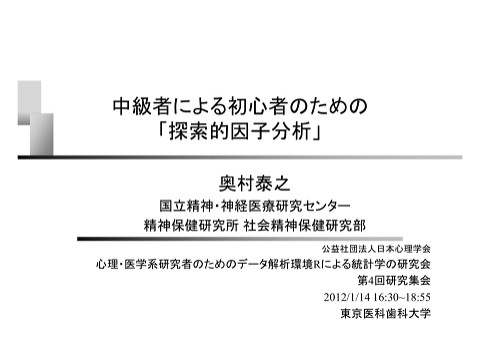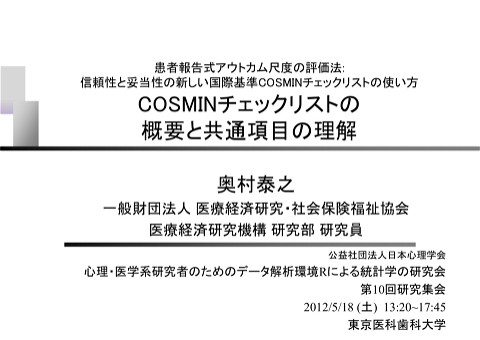中級者による初心者のための「綿形混合モデル」
217.3K Views
May 24, 22
スライド概要
関連スライド
各ページのテキスト
中級者による初心者のための 「線形混合モデル」 奥村泰之 国立精神・神経医療研究センター 精神保健研究所 社会精神保健研究部 第2回 心理・医学系研究者のためのデータ解析環境Rによる統計学の研究会 2011/8/20 16:30~19:10 東京医科歯科大学
話題 線形混合モデル (LMM) の特徴 (6 min) Reporting Guidelineと適正報告調査 (3 min) Reporting Guidelineの項目詳細 (25 min) Rによる線形混合モデル (LMM) (0 min) 中級者向けの推薦文献 (1 min) 2
線形混合モデル (LMM) の特徴 英語表記 • • • • • Linear mixed model(ing) ( g) Multilevel model(ing) Hierarchical linear model(ing) ( g) Random effect model(ing) Growth curve model(ing) 3
線形混合モデル (LMM) の特徴 独立変数と従属変数の尺度水準 1つの従属変数 • 量的変数 1つ以上の固定効果要因 • 名義尺度,順序尺度,間隔尺度,比尺度なんでもOK 1つ以上の変量効果要因 • 「反復測定した調査対象者」 • 「複数の調査対象者を含む病院」など sub1 t1 t2 subi tj t1 t2 hosp1 tj s1 s2 hospi sj s1 s2 sj 4
線形混合モデル (LMM) の特徴 反復測定データにおける,LMMの使用目的 変化の軌跡は 線形 2次あるいは3次関数か? 変化の軌跡は,線形,2次あるいは3次関数か? • 介入Aの効果は,一定の時間が経つと消失するか? 基準時 (切片) の値は,人により,どの程度異なるか? の値は 人により どの程度異なるか? 変化の程度 (傾き) は,人により,どの程度異なるか? 基準時 (切片) の値と,関連する要因は何か? • 介入Aと介入Bの介入後のアウトカム (切片) に差はあるか? 変化の程度 (傾き) と,関連する要因は何か? • 介入 介入Aと介入Bの効果 介入 効果 (傾き) に影響を与える要因は何か? 影響を与 る要因 何 基準時 (切片) の値と,変化の程度 (傾き) の関係は,ど の程度あるか? Ferron et al: Multilevel Modeling of Educational Data: 391-426, 2008 5
線形混合モデル (LMM) の特徴 事例①(変化の軌跡) 目的 • 老化に伴う心肺機能の低下の程度を検討する 従属変数 男性 • 心肺機能 固定効果要因 • 生活スタイル,性別など 女性 変量効果要因 • 反復測定 (2~33回) した調査対象者 結果 • 45歳を過ぎると心肺機能は, 加速的に低下する Jackson et al: Arch Intern Med 169:1781-1787, 2009 6
線形混合モデル (LMM) の特徴 事例②(切片と傾きの関連要因) 目的 • パーソナリティ障害の症状の持続性について検討する 従属変数 男性 • パーソナリティ障害の重症度 陽性群 固定効果要因 • パーソナリティ障害の診断,性別など 女性 変量効果要因 • 反復測定 (3回) した調査対象者 陰性群 結果 • 重症度は時間と共に軽減する • 陽性群 (PPD) は,陰性群 (NPD) よりも,軽減率 (傾き) が高い • 男性は,女性よりも,基準時の重症度 (切片) が高い Lenzenweger et al: Arch Gen Psychiatry 61:1015-1024, 2004 7
話題 線形混合モデル (LMM) の特徴 (6 min) Reporting Guidelineと適正報告調査 (3 min) Reporting Guidelineの項目詳細 (25 min) Rによる線形混合モデル (LMM) (0 min) 中級者向けの推薦文献 (1 min) 8
LMMの適正報告調査とReporting Guideline 適正報告調査 特徴 • LMMの適正報告に関する基準をn個作成 • LMMを使用した論文を系統的に検索 LMMを使用した論文を系統的に検索・収集 収集 • LMMの適正報告に関する基準を満たしているか評定 論文 • Dedrick et al: Multilevel Modeling: A Review of Methodological Issues and Applications (Rev Educ Res 79: 69-102, 2009)...41個 • Schreiber et al: Review of multilevel modeling and multilevel studies in The Journal of Educational Research (1992-2002) (J Educ Res 98: 24-33, 2004)...12個 9
LMMの適正報告調査とReporting Guideline Reporting Guideline 特徴 • LMMの適正報告に関する基準をn個作成 • 基準の詳細な説明 論文 • Jackson: Reporting results of latent growth modeling and multilevel modeling analyses: some recommendations for rehabilitation psychology (Rehabil Psychol 55: 272-85, 2010)...23個 • McCaoach: Hierarchical linear modeling g ((The reviewer’s g guide to q quantitative methods in the social sciences: 123-140, 2010)...19個 • Ferron et al: Reporting results from multilevel analyses (Multilevel Modeling of Educational Data: 391-426, 2008)...37個 10
LMMの適正報告調査とReporting Guideline JacksonのReporting Guideline 線形混合モデルのReporting Guideline • 縦断研究におけるLMMの適正報告に関する基準を23個作成 • 基準の詳細な説明 Jackson: Rehabil Psychol 55: 272-85, 2010 11
LMMの適正報告調査とReporting Guideline JacksonのReporting Guideline 4局面 23項目のReporting Guideline 4局面,23項目のReporting • • • • (1) 理論の定式化とデータ収集の局面 (6項目) (2) デ データ整理の局面 タ整理の局面 (5項目) (3) 分析の決定の局面 (7項目) (4) モデルの評価,推定と再指定の局面 モデルの評価 推定と再指定の局面 (5項目) Jackson: Rehabil Psychol 55: 272-85, 2010 12
LMMの適正報告調査とReporting Guideline JacksonのReporting Guideline (1) 理論の定式化とデ 理論の定式化とデータ収集の局面 タ収集の局面 • • • • ①独立・従属変数と,研究仮説との関係を記述すること ②LMMのデータ構造と研究仮説との関係を報告すること ②LMMのデ タ構造と研究仮説との関係を報告すること ③測定回数と測定間隔の設定根拠を述べること ④従属変数の適切性 (天井効果・床効果の可能性,項目の (天井効果・床効果の可能性 項目の 学習効果) について記述すること • ⑤標本サイズの設計根拠を報告すること • ⑥検討予定の全モデルを記述すること Jackson: Rehabil Psychol 55: 272-85, 2010 13
LMMの適正報告調査とReporting Guideline JacksonのReporting Guideline (2) デ データ整理の局面 タ整理の局面 • • • • • ①欠損値の状態と欠損値の種類について記述すること ②欠損値への対処法を記述すること ③分布の問題 (2峰性,高い歪度など) を記述すること ④主要な変数の要約統計量を報告すること ⑤仮定 (線形性,正規性など) を満たすかを確認すること Jackson: Rehabil Psychol 55: 272-85, 2010 14
LMMの適正報告調査とReporting Guideline JacksonのReporting Guideline (3) 分析の決定の局面 • ①分析上の利点から,LMMを使用する場合,その理由を強 調する と 調すること • ②ソフトウェア名とバージョンを記述すること ③時間に関する変数のコ ド化について報告すること • ③時間に関する変数のコード化について報告すること • ④変化の軌跡を述べること • ⑤母数推定法を記述すること • ⑥変数のセンタリングについて報告すること • ⑦仮定した誤差共分散について記述すること Jackson: Rehabil Psychol 55: 272-85, 2010 15
LMMの適正報告調査とReporting Guideline JacksonのReporting Guideline (4) モデルの評価,推定と再指定の局面 モデルの評価 推定と再指定の局面 • ①モデルの評価法を明記すること • ②モデル比較の結果を明記すること • ③変化の軌跡を議論するとき,予測値と実測値を比較する こと • ④推定結果は信頼区間と共に示し,標準偏回帰係数か否 かを明記すること • ⑤検討予定になかったモデルは,その旨を明記すること Jackson: Rehabil Psychol 55: 272-85, 2010 16
話題 線形混合モデル (LMM) の特徴 (6 min) Reporting Guidelineと適正報告調査 (3 min) Reporting Guidelineの項目詳細 (25 min) Rによる線形混合モデル (LMM) (0 min) 中級者向けの推薦文献 (1 min) 17
Reporting Guidelineの項目詳細 (1)-⑤標本サイズの設計根拠 基準 • 標本サイズの設計根拠を報告すること 検討法 • 主要評価項目の2変量解析の検定力分析を実施 • LMM用の検定力分析を実施 – テクニカルなので説明/解析例は省略。詳細は,成書を参照のこと。 – (Hox JJ :Multilevel analysis: Techniques and applications applications. Routledge, 2010) 18
Reporting Guidelineの項目詳細 (1)-⑤標本サイズの設計根拠 事例 • 主要評価項目の2変量解析の検定力分析を実施 – 方法の節 » We expected a between-treatment effect size (Cohen d) of 0.80 for the primary outcome. At a power level of .80 (1−β), we calculated the sample size per treatment group at an adjusted error probability of .025 because of multiple testing. Assuming equally sized groups, a sample size of 26 per treatment group was calculated l l d using i G*P G*Power. We W anticipated low loss to follow-up because our experiences from prior studies in the area were that individuals are readily traceable within the boundaries of the IDP camps. Therefore, and because of logistical and resource p g screening, g, we aimed constraints to extend epidemiologic for a sample size of 28 per group. Ertl et al: JAMA 306(5):503-512, 2011 19
Reporting Guidelineの項目詳細 (1)-⑥検討予定の全モデルを記述 基準 • 検討予定の全モデルを記述すること • 数式を併記することが望ましい 主要なモデル • Unconditional Mean Model • Unconditional Growth Model • Conditional C diti lG Growth th M Model d l 20
Reporting Guidelineの項目詳細 (1)-⑥検討予定の全モデルを記述 説明用データセット 説明用デ タセット (GPA Data) • 大学生の成績 (GPA) の変化 – 架空データ 架空デ タ – 200人の大学生を6時点 (1-3年生×前期-後期) で追跡調査 変数名 説明 コード コ ド 役割 id 被験者id 量的変数 変量効果 time 測定時点 (ref = 1年生-前期) 量的変数 (0-5) 変量-固定効果 gpa 成績 (GPA) 量的変数 従属変数 job 平均労働時間/週 量的変数 固定効果 (時間依存共変量) sex 性別 (ref = 女性) 質的変数 固定効果 high 高校生の時の成績 (GPA) 量的変数 固定効果 Hox JJ :Multilevel analysis: Techniques and applications. Routledge, 2010 21
Reporting Guidelineの項目詳細 (1)-⑥検討予定の全モデルを記述 説明用データセット 説明用デ タセット (GPA Data) • 被験者idが1と2のデータ例 gpa Yij (id i, time j ) gp データは縦に並べる id 1 1 1 1 1 1 2 2 2 2 2 time 0 1 2 3 4 5 0 1 2 3 5 gpa job sex 2.3 2 female 21 2.1 2 f female l 3 2 female 3 2 female 3 2 female 3.3 時間依存共変量 2 female 2.2 2 male 2.5 3 male 2.6 2 male 2.6 2 male 2.8 2 male Hox JJ :Multilevel analysis: Techniques and applications. Routledge, 2010 high 2.8 28 2.8 2.8 2.8 2.8 2.8 2.5 2.5 2.5 2.5 2.5 22
Reporting Guidelineの項目詳細 (1)-⑥検討予定の全モデルを記述 Unconditional Mean Model • 特徴 Level 1 (id = 1) 0 1 2 3 time 4 5 gpa 2.0 2.5 5 3.0 3.5 3 4.0 gpa 2.0 2.5 5 3.0 3.5 3 4.0 – 個人内の変化 (傾き) はない – 個人間で平均値 (切片) は異なる Level 2 0 1 2 3 time 4 5 23
Reporting Guidelineの項目詳細 (1)-⑥検討予定の全モデルを記述 • 数式 Level1 : Y ij 0 i ij Level2 : 0 i 00 0 i gpa 2.0 2.5 3.0 3.5 4.0 Unconditional Mean Model Level 1 (id = 1) Y15 01 • Level 1 = 個人内の変動 • π0i = 個人の得点の平均値 • εijj = 個人の平均からの偏差 (誤差) 12 Y10 0 1 2 3 time 4 5 24
Reporting Guidelineの項目詳細 (1)-⑥検討予定の全モデルを記述 • 数式 gpa 2.0 2.5 3.0 3.5 4.0 Unconditional Mean Model Level 2 Level1 : Y ij 0 i ij Level2 : 0 i 00 0 i • Level 2 = 個人間の変動 • γ00 = 全体の得点の平均値 • ζ0i = 全体の平均値からの 個人の平均値の偏差 0i 00 0 1 2 3 time 4 5 25
Reporting Guidelineの項目詳細 (1)-⑥検討予定の全モデルを記述 Unconditional Growth Model • 特徴 0 1 2 3 time 4 5 gpa 2.0 0 2.5 3.0 3.5 5 4.0 gpa 2.0 0 2.5 3.0 3.5 5 4.0 – 個人内の変化 (傾き) はある – 個人間で基準時 (切片) の値は異なる – 個人間で変化の程度 (傾き) は異なる Level 1 (id = 1) 0 Level 2 1 2 3 time 4 5 26
Reporting Guidelineの項目詳細 (1)-⑥検討予定の全モデルを記述 • 数式 Level1 Y ij 0 i 1 i T ij ij Level2 0 i 00 0 i 1i 10 1i • • • • • gpa 2.0 2.5 3.0 3.5 4.0 Unconditional Growth Model Level 1 (id = 1) Y15 Y10 01 Level 1 = 個人内の変動 π0i = 個人の基準時 (切片) の値 π1i = 個人の変化の程度 (傾き) 0 Tij = 時点 εij = 個人の変化の軌跡からの偏差 (誤差) 11 11 1 2 3 time 4 5 27
Reporting Guidelineの項目詳細 • 数式 Level1 Y ij 0 i 1 i T ij ij Level2 0 i 00 0 i 1i 10 1i • • • • • gpa 2.0 2.5 3.0 3.5 4.0 (1)-⑥検討予定の全モデルを記述 Unconditional Growth Model 00 Level 2 = 個人間の変動 γ00 = 全体の基準時 (切片) の値 ζ0i = 全体の切片と個人の傾きの偏差 γ10 = 全体の変化の程度 (傾き) ζ1i = 全体の傾きと個人の傾きの偏差 0 i 10 1 i T j Level 2 00 10 T j 0 1 2 3 time 4 5 28
Reporting Guidelineの項目詳細 (1)-⑥検討予定の全モデルを記述 Conditional Growth Model • 特徴 Level 2 (女性 ) 0 1 2 3 time 4 5 gpa 2.0 2.5 5 3.0 3.5 4.0 gpa 2.0 2.5 5 3.0 3.5 4.0 – 個人間で基準時 (切片) の値は異なる – 個人間で変化の程度 (傾き) は異なる – 基準時 (切片) の値と変化の程度 (傾き) は,他の要因と関連する Level 2 (男性 ) 0 1 2 3 time 4 5 29
Reporting Guidelineの項目詳細 (1)-⑥検討予定の全モデルを記述 Conditional Growth Model • 数式 – Unconditional Growth Model とLevel 1は同一 1は同 • • • • • • • • 00 Level 2 = 個人間の変動 γ00 = 女性全体の基準時 (切片) の値 γ01 = 男性と女性の個人の切片の値の平均値差 Xij = 性別 (女性0, (女性0 男性1) ζ0i = 女性全体の切片と個人の傾きの偏差 γ11 = 男性と女性の個人の傾きの平均値差 γ10 = 女性全体の変化の程度 (傾き) ζ1i = 女性全体の傾きと個人の傾きの偏差 Level 2 (女性) 0 1 2 3 time 4 5 01 10 11 T j gpa a 2.0 0 2.5 3.0 3.5 4.0 Level2 0 i 00 01 X ijj 0 i 1i 10 11 X ij 1i g gpa 2.0 2.5 3 3.0 3.5 4.0 4 00 10 T j Level 2 (男性) 0 1 2 3 time 4 5 30
Reporting Guidelineの項目詳細 (1)-⑥検討予定の全モデルを記述 事例 – 方法の節 » First, we conducted a set of unconditional growth analyses in which we posited a linear individual change trajectory at level 1, but did not attempt to predict inter-individual variation in the g growth p parameters by y between-subject j factors. ....(中略).... Second, we conducted a set of conditional analyses in which we examined systematic inter-individual inter individual differences in intercept and slope as a function of 3 between-subject predictors, namely study group (PPD vs NPD), subject sex, and age in years at entry into the study study. Lenzenweger et al: Arch Gen Psychiatry 61:1015-1024, 2004 31
Reporting Guidelineの項目詳細 (1)-⑥検討予定の全モデルを記述 事例 – 方法の節 (Table) Lenzenweger et al: Arch Gen Psychiatry 61:1015-1024, 2004 32
Reporting Guidelineの項目詳細 (2)-①欠損値の状態と欠損値の種類 基準 • 欠損値の状態と欠損値の種類について記述すること LMMで対処可能な欠損値の種類 • MCAR (missing completely at random) – 従属変数の欠損確率 (反復測定の脱落確率) は,(1) は (1) 測定時点, 測定時点 (2) 他の変数の値,(3) 未測定の従属変数の値と相関しない • MAR ((missing g at random)) – 従属変数の欠損確率は,測定している変数の値と関係するが,未 測定の変数の値と関係しない Singer W: Applied Longitudinal Data Analysis: Modeling Change and Event Occurrence. Oxford, 2003 33
Reporting Guidelineの項目詳細 (2)-①欠損値の状態と欠損値の種類 事例 測定時点 – 方法の節 » Appendix Table 1 shows results on the extent of missing data. 分析対象者数 脱落者数 一時的な欠損数 – 付録の節 測定人数 適格基準の 対象外数 McMahon et al: Ann Intern Med 42:333-341, 2005 34
Reporting Guidelineの項目詳細 (2)-①欠損値の状態と欠損値の種類 事例 – 方法の節 » Primary analysis used a linear mixed model, which assumed that the missing data were missing at random (dependent on observed data but independent of the antiHBs level at the time of the missed observation). ) – 考察の節 » The absence of a detected association between missing observations b ti and d previous i anti-HBs ti HB llevels l supports t the th assumption made in the use of a linear mixed model that data are missing at random (independent of the anti-HBs level at the time of the missed data point). We believe the design and conduct of the study support this assumption, as does the lack of dependence p between missing g observations and previous anti-HBs levels. McMahon et al: Ann Intern Med 42:333-341, 2005 35
Reporting Guidelineの項目詳細 (2)-④要約統計量 基準 • 主要な変数の要約統計量を報告すること – 平均値,標準偏差,歪度,尖度,最小値,最大値,相関係数など 事例 – 結果の節 » Mean scores on the substance-use measure at Waves 1, 4, and 7 were 0.66 (SD = 1.40, skewness = 4.00, kurtosis = 21 08 range = 0–11), 21.08, 0 11) 1 1.63 63 (SD = 2.55, 2 55 skewness k = 1.61, 1 61 kurtosis = 1.71, range = 0–10), and 2.56 (SD = 2.82, skewness = 1.17, kurtosis = 0.69, range = 0–12), respectively. We transformed the resulting scores by natural log to increase the normality of the distributions. Greenbaum et al: J Emot Behav Disord 15: 21-32, 2007 36
Reporting Guidelineの項目詳細 (3)-③時間に関する変数のコード化 基準 • 時間に関する変数のコード化について報告すること 種類 • 測定開始時を基準時 (切片) とする • 測定終了時を基準時 (切片) とする 37
Reporting Guidelineの項目詳細 (3)-③時間に関する変数のコード化 事例 • 測定開始時を基準時 (切片) とする – 方法の節 » Lipid concentrations (including concentrations of LDL cholesterol, high-density lipoprotein cholesterol, and triglycerides) were measured at randomization, randomization 6 and 12 months later, and then every 12 months for 5 years. – 付録の節 » In our calculations on the LIPID trial, baseline is actually 6 months, because we started timing from when the cholesterol level stabilized after commencement of pravastatin treatment. We therefore use 0, 0.5, 1.5, 2.5, 3.5, and 4.5 for time values at 6 months and 1 through 5 years respectively. years, respectively Glasziou et al: Ann Intern Med 148:656-661, 2008 38
Reporting Guidelineの項目詳細 (3)-③時間に関する変数のコード化 事例 • 測定終了時を基準時 (切片) とする – 方法の節 » Teacher and student post-intervention data were collected at three additional times, at the end of the 8th grade school year and again in the fall and spring of the following year year. – 結果の節 e sshow o d direct ect e effects ects at tthe ee end do of 8t 8th g grade ade a and do over e » We time (through the end of 9th grade). For the longitudinal models predicting change in self-regulatory behavior and academic outcomes outcomes, we set the intercept for time at spring of 9th grade to obtain estimates of between-condition effects at the final measurement point. Oyserman et al: J Pers Soc Psychol 91:188-204, 2006 39
Reporting Guidelineの項目詳細 (3)-④変化の軌跡 3.5 3.0 gpa 2.5 2.0 • 変化の軌跡を述べること 種類 0 2 3 4 5 4 5 4 5 time Level 1 (id = 193) gpa 3.0 3 3.5 • 線形 (linear change) 2.5 • 2次 (quadratic change) 2.0 – 測定回数: 4時点以上 0 • 3次 (cubic change) 1 2 3 time 3.5 Level 1 (id = 120) gpa 3.0 – 測定回数 測定回数: 5時点以 5時点以上 2.5 – 測定回数: 3時点以上 1 2.0 基準 Level 1 (id = 5) 0 1 2 3 time 40
Reporting Guidelineの項目詳細 (3)-④変化の軌跡 事例 • 2次 (quadratic change) – 方法の節 » Linear mixed models (LMM) regression was used to analyze the longitudinal data. A random intercept growth model was used to define the longitudinal age-associated age associated change in CRF. The patient’s age was the measure of time for the growth model. ...(中略)... The first model examined the h nonlinear li llongitudinal i di l change h iin CRF d due to aging. i Th The second model added the lifestyle variables to the age model. ...(中略)... The variables of the LMM fixed-effects portion of the model were age, age2, BMI, PAI, and smoking behavior. Jackson et al: Arch Intern Med 169:1781-1787, 2009 41
Reporting Guidelineの項目詳細 (3)-⑤母数推定法 基準 • 母数推定法を記述すること 種類 • (完全情報) 最尤推定法 – (Full Information) Maximum Likelihood Estimation: ML » 利点: 固定効果要因のモデル比較ができる » 欠点: 標本サイズが小さい場合の推定精度が悪い 標 場 定 度 • 制限付き最尤推定法 – Restricted Maximum Likelihood Estimation: REML » 利点: 標本サイズが小さい場合でも推定精度が良い » 欠点: 固定効果要因のモデル比較はできない 42
Reporting Guidelineの項目詳細 (3)-⑤母数推定法 事例 • (完全情報) 最尤推定法 – 方法の節 » In our analyses, the hypothesized levels 1 and 2 statistical models were fitted simultaneously to the LSPD data using full maximum likelihood estimation and the HLM full-maximum HLM-5 5 computer program.1) • 制限付き最尤推定法 – 結果の節 » Given the small Level 2 sample size, we used restricted maximum likelihood estimation for all HLM analyses.2) 1) Lenzenweger et al: Arch Gen Psychiatry 61:1015-1024, 2004; 2) Reis et al: J Educ Res101: 299-315, 2008 43
Reporting Guidelineの項目詳細 (4)-②モデル比較の結果 基準 • モデル比較の結果を明記すること 種類 • 尤度比検定 (Likelihood Ratio Test) – 特徴 » 対数尤度が大きいモデルの適合が良いと判断する » 逸脱度 度 ((−2×対数尤度) 数 度) が小さいモデルの適合が良いと判断 良 する – 利点 » 検定が可能 – 欠点 » ネストしていないモデルは比較できない 44
Reporting Guidelineの項目詳細 (4)-②モデル比較の結果 種類 • 情報量規準 (Information Criterion) – 種類 » 赤池情報量規準 (Akaike Information Criterion: AIC) » ベイズ情報量規準 (Bayesian Information Criterion: BIC) – 特徴 » 情報量規準の値が小さいモデルの適合が良いと判断する – 利点 » ネストしていないモデルの比較もできる – 欠点 » どの程度の値の差があれば,適合が悪い/良いモデルと判断す るか不明瞭 45
Reporting Guidelineの項目詳細 (4)-②モデル比較の結果 ネストの判定 • ネストとは – Model 2の一部に制約 2の 部に制約 (e.g., 交互作用項を0と置く) を加えることで Model 1を表現可能 • モデルの例 – M1: y=β0+β1x1+β2x2 – M2: y=β0+β1x1+β2x2+β3x3 – M3: y=β β0+β1x1+β2x2 + β4x4 • ネストの判定例 – M1はM2のβ3を0と制約することで表現可能 (M1はM2にネストしている) – M1はM3にネストしている – M2はM3にネストしていない,M3はM2にネストしていない Long JS: Regression models for categorical and limited dependent variables. SAGE, 1997 46
Reporting Guidelineの項目詳細 (4)-②モデル比較の結果 Model 1 vs Model 2 事例 – 結果の節 モデル比較 Wang et al: Dev Psychol. in press 47
Reporting Guidelineの項目詳細 (4)-④推定結果 基準 • 推定結果は信頼区間と共に示し,標準偏回帰係数か否か を明記する と を明記すること 種類 • (非標準化) 偏回帰係数 – 当該独立変数以外の値を一定にした条件下で, 当該独立変数を1単位動かしたときの,従属変数の平均的な変化 • 標準偏回帰係数 – 標準偏回帰係数の解釈は難しいので,使用しないことが多い 48
Reporting Guidelineの項目詳細 (4)-④推定結果 事例 – 結果の節 偏回帰係数と信頼区間 脚注 Sanders et al: JAMA 303:150-158, 2010 49
Reporting Guidelineの項目詳細 (4)-④推定結果 事例 性別等を調整しない モデルの推定値 – 付録の節 性別等を調整した モデルの推定値 項 項の解釈 結果果に抜粋 Brown et al: Ann Intern Med 150:372-378, 2009 50
Reporting Guidelineの項目詳細 (4)-④推定結果 事例 – 結果の節 結果を解釈しやすい言葉に変換 (従属変数は活動性) 1. 2. 3. 手術群と非手術群の活動性の 「入院前の平均値」と「その平均値差」 手術群と非手術群の入院前後の 活動性の「平均値の変化」と「その平均値差」 手術群と非手術群の退院後の ((1週間の対数ごとの)) 「活動性の経過」と「その平均値差」 付録の抜粋 Brown et al: Ann Intern Med 150:372-378, 2009 51
話題 線形混合モデル (LMM) の特徴 (6 min) Reporting Guidelineと適正報告調査 (3 min) Reporting Guidelineの項目詳細 (25 min) Rによる線形混合モデル (LMM) (0 min) 中級者向けの推薦文献 (1 min) 52
Rによる線形混合モデル (LMM) LMM関係の主要なRパッケージと関数 library(doBy) • summaryBy()...独立変数の水準ごとの要約統計量 library(e1071) • skewness()...歪度 • kurtosis()...尖度 k t i () 尖度 library(nlme) • lme()...線形混合モデルの関数 source(“plot.repeated.r”) • plot.repeated()...個人の変化を図示するオリジナル関数 53
Rによる線形混合モデル (LMM) 説明用データセット GPA Data (gpa.csv) (gpa csv) • 大学生の成績 (GPA) の変化 – 架空データ 架空デ タ – 200人の大学生を6時点 (1-3年生×前期-後期) で追跡調査 変数名 説明 コード コ ド 役割 id 被験者id 量的変数 変量効果 time 測定時点 (ref = 1年生-前期) 量的変数 (0-5) 変量-固定効果 gpa 成績 (GPA) 量的変数 従属変数 job 平均労働時間/週 量的変数 固定効果 (時間依存共変量) sex 性別 (ref = 女性) 質的変数 固定効果 high 高校生の時の成績 (GPA) 量的変数 固定効果 Hox JJ :Multilevel analysis: Techniques and applications. Routledge, 2010 54
Rによる線形混合モデル (LMM) 説明用データセット 研究目的 • 大学生の成績 (GPA) の変化の関連要因を検討する モデル • 従属変数 – 成績 (GPA) • 固定効果要因 – 性別 • 変量効果要因 – 反復測定した調査対象者 • 検討する全モデル – Unconditional Mean Model – Unconditional Growth Model – Conditional Growth Model 55
Rによる線形混合モデル (LMM) ①分析データセットの作成と従属変数の要約統計量の確認 56
Rによる線形混合モデル (LMM) ①分析データセットの作成と従属変数の要約統計量の確認 summaryBy(formula, data, FUN) • 独立変数の水準ごとに要約統計量を算出する関数 – formula = 従属変数 ~ 独立変数 » チルダ[~]の左側に1つ以上の従属変数の変数名 » チルダ[~]の右側に1つ以上の独立変数の変数名 – data = データフレーム デ タフレ ム – FUN = 任意の関数 57
Rによる線形混合モデル (LMM) ①分析データセットの作成と従属変数の要約統計量の確認 結果抜粋 結果抜粋 – 時点0~5の歪度は,−0.06~0.19 – 時点0~5の尖度は,−0.64~0.67 – 正規性に異常性はみられないと考えられる 58
Rによる線形混合モデル (LMM) ②従属変数の変化の軌跡を確認 plot.repeated(idvar, yvar, timevar, type, pooled=FALSE, data) • 個人の変化を図示するオリジナル関数 – – – – idvar = 被験者を識別する変数名 (文字列) yvar = 従属変数名 (文字列) timevar = 時間に関する変数名 (文字列) type = 変化の軌跡の形状 » “lin” = 線形 » “quad” q = 2次関数 次関数 » “cubic” = 3次関数 » “no” = 切片のみ (変化なし) – pooled » FALSE = 個人別に図示 » TRUE = 集団全体で図示 – data = データフレーム 59
Rによる線形混合モデル (LMM) ②従属変数の変化の軌跡を確認 60
Rによる線形混合モデル (LMM) ③Unconditional Mean Model lme(fixed, random, data, method=“REML”) • 線形混合モデルの関数 – – – – fixed = 従属変数 ~ 1 data = データフレーム random = ~ 1|被験者を識別する変数名 method » “REML” = 制限付き最尤推定法 » “ML” = 最尤推定法 Level1 : Y ij 0 i ij Level2 : 0 i 00 0 i Y ij 00 0 i ij 61
Rによる線形混合モデル (LMM) ③Unconditional Mean Model summary(object) • 線形混合モデルの結果を要約する関数 – object = lme()の結果を保存したオブジェクト名 VarCorr(object) • 線形混合モデルの分散成分を表示する関数 intervals(object) • 線形混合モデルの信頼区間を表示する関数 Y ij 00 0 i ij 62
Rによる線形混合モデル (LMM) ③Unconditional Mean Model 3.2 3.0 2.8 2.6 2.4 pred • 全体のGPAの得点の平均値は2.87 • 個人間のGPAのばらつき (標準偏差) は0.24 • 個人内のGPAのばらつき 個人内のGPAのばら き (標準偏差) は0.31 は0 31 3.4 結果抜粋 0 1 2 3 4 5 time 63
Rによる線形混合モデル (LMM) ④Unconditional Growth Model lme(fixed, random, data, method=“REML”) • 線形混合モデルの関数 – – – – fixed = 従属変数 ~ 固定効果要因 data = データフレーム random = ~時間に関する変数名|被験者を識別する変数名 method » “REML” = 制限付き最尤推定法 » “ML” = 最尤推定法 Level1 Y ij 0 i 1i T ij ij Y ij 00 10 T ij 0 i 1 i T ij ij Level2 0 i 00 0 i 1i 10 1i 64
Rによる線形混合モデル (LMM) 4.0 ④Unconditional Growth Model 3.0 2.5 • 1年生の前期のGPAの得点の平均値は2.60 • GPAの得点は,半年ごとに平均0.11点上がる • 個人内の変化の軌跡からの標準偏差は0.20 個人内の変化の軌跡からの標準偏差は0 20 pred 3.5 3 結果抜粋 – Unconditional Mean Modelでは0.31であった。 本モデルの方が個人内の変動を,より説明できている。 0 1 2 3 4 5 time Y ij 00 10 T ij 0 i 1 i T ij ij 65
Rによる線形混合モデル (LMM) ⑤Conditional Growth Model lme(fixed, random, data, method=“REML”) • 線形混合モデルの関数 – – – – fixed = 従属変数 ~ 固定効果要因 data = データフレーム random = ~時間に関する変数名|被験者を識別する変数名 method » “REML” = 制限付き最尤推定法 » “ML” = 最尤推定法 Level1 Y ij 0 i 1 i T ij ij Y ij 00 01 X ij 10 T ij 11 X ij T ij 0 i 1 i T ij ij Level2 0 i 00 01 X ij 0 i 1i 10 11 X ij 1i 66
Rによる線形混合モデル (LMM) 女性 ⑤Conditional Growth Model 3.5 pred 3.0 0 1 2 3 4 5 3 4 5 time pred 3.5 男性 3.0 3 Y ij 00 01 X ij 10 T ij 11 X ij T ij 0 i 1 i T ij ij 2.5 1年生の前期の女性の平均値は2.64 1年生の前期の得点は男性の方が0.76点低い 女性の得点は 半期ごとに平均0 12点上がる 女性の得点は,半期ごとに平均0.12点上がる 半年ごとの得点の変化の程度は, 男性 方 男性の方が0.03点低い 点低 2.5 • • • • 4.0 結果抜粋 0 1 2 time 67
Rによる線形混合モデル (LMM) ⑥モデル比較 anova(model1, model2) • 複数のモデルを比較する関数 – model1/model2 = lme()の結果を保存したオブジェクト名 結果抜粋 情報量規準と 尤度比検定 – Unconditional Mean ModelとUnconditional Growth Modelの比較 » AICとBICともに,後者のモデルの適合が良いと判断 » 尤度比検定の結果,対数尤度も後者のモデルが良好であると判断 – Unconditional U diti lG Growth th M ModelとConditional d lとC diti lG Growth th M Modelの比較 d lの比較 » AICとBICともに,後者のモデルの適合が良いと判断 » 尤度比検定の結果,対数尤度も後者のモデルが良好であると判断 68
話題 線形混合モデル (LMM) の特徴 (6 min) Reporting Guidelineと適正報告調査 (3 min) Reporting Guidelineの項目詳細 (25 min) Rによる線形混合モデル (LMM) (0 min) 中級者向けの推薦文献 (1 min) 69
中級者向けの推薦文献 教科書 • Applied pp Longitudinal g Data Analysis: y Modeling g Change g and Event Occurrence – – – – – http://www.amazon.co.jp/dp/0195152964 縦断データ解析の成書 (線形混合モデルと生存時間分析) 豊富な解析事例と詳細な解釈例を掲載 基礎的な統計学の教科書を読了していれば読める数学レベル 生データとプログラム (R,STATA,SASなど) が公開されている 70

